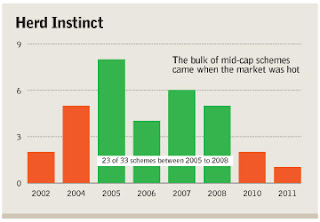If you want to buy mid-cap funds, keep these points in mind
Investors are exposed to a lot of discussion about small- and mid-cap mutual fund (MF) schemes. They are advised to invest in mid-cap schemes as they think small- and mid-sized companies tend to be under-researched. Mid-cap schemes present an opportunity to invest in companies that are yet to be identified by the market and such companies offer higher growth potential. If the mid-cap schemes do their job properly, you would benefit from higher returns. Valuation of such small- and mid-sized companies also tends to be lower which compounds the future returns. Mid-cap companies have the potential to join the league of large-cap companies and, as the market 'discovers' that, they fetch higher valuation. Such companies are supposed to be nimble, flexible and can adapt faster to changes.
Mid-cap stocks and small-cap stocks rise the fastest when the economy is in a growth mode. They are the blue-chips of tomorrow. That has made mid-cap stocks the darlings of the Indian bull market. However, they are volatile. They fall as quickly as they rise and, therefore, wrong timing can decimate your returns. Wrong timing can happen because you have chosen to buy mid-cap schemes before a crash or the funds have chosen to buy mid-cap stocks as they are about to face a difficult period. Morgan Stanley launched its first Indian MF scheme in 1994 which carried a lot of small- and mid-cap stocks. The scheme suffered severe value erosion of 35% over the next seven years.
Mid-cap schemes are also supposed to be a good option for investors who want to add some diversity to their portfolio. We disagree. There are several reasons why Moneylife prefers equity diversified schemes to small- and mid-cap schemes.
No Long-term Record: Firstly, mid- and small-cap schemes have no long-term track record. Mid-cap schemes have a past of less than 10 years. The first such scheme was Sundaram Select Mid-cap, launched in mid-2002. Apart from Sundaram, one more scheme was launched in 2002—Birla Sun Life Mid-cap Fund—which gave returns of 31% since inception. And, of the five funds that came in 2004, the best performer was UTI Mid-cap that has given a return of 18% since launch. It outperformed its benchmark, BSE Small Cap, for the same period by 24%.
Timing: If you were not one of the early buyers of mid-cap schemes, you have missed the mid-cap rally. The bulk of them came in the 2005-08 period, following a once-in-a-lifetime rally. Of the total 33 schemes that exist now, 23 came in this period (see chart Herd Instinct). The average return from these 23 funds is 10%; only 13 schemes gave above-average returns. Of these, the best performers were Principal Emerging Bluechip, launched in November 2008 (timed wonderfully with a market bottom), which has given a return of 46% since inception and Religare Mid N Small Cap, launched in March 2008 (timed badly), which has still given a superb return of 13% since inception.
Unclear Strategy: Many mid-cap schemes don't buy just mid-cap stocks and stray from their objective. There are many examples of mid-cap schemes that have ended up investing in large-cap stocks. For example, Axis Mid-cap Fund has invested in Infosys and Petronet LNG; Birla Sun Life Mid-cap Fund has invested in stocks like GlaxoSmithKline Consumer, Cadila Healthcare and Cummins India; and BNP Paribas Mid-cap Fund has NTPC, Lupin and UltraTech Cement in its portfolio. Clearly, MFs are quick to stray from the investment objective when it suits them.
No Better: Have the best mid-cap schemes done significantly better than equity diversified schemes? We compared the performance of the mid-cap schemes with equity diversified schemes since 2002 when the first mid-cap scheme was launched. The top five equity diversified schemes have given the same returns as Sundaram and Birla Sun Life Mid-cap schemes, that is, between 30% and 36%. The top five equity diversified schemes giving a return in this range include Reliance Growth, HDFC Equity, Reliance Vision, DSP BlackRock Opportunities and HDFC Growth. The average return of these schemes from 2002-2011 is 32%. So why go for mid-cap schemes?
When you are getting the same returns with a diversified portfolio, why should you take the risk of investing in a mid-cap scheme which brings added risk? In other words, an equity diversified scheme allows an investor to diversify into several stocks and sectors for a nominal investment. This diversification allows investors to reduce the risk of one particular stock or sector, as well as has more potential for higher reward by offering a broader exposure to various stocks and sectors.
The key rationale for diversification is: "…so that a failure in or an economic slump affecting one of them will not be disastrous." In other words, don't put all your eggs in one basket. Secondly, equity diversified schemes are the oldest ones; so they have a reasonable track record to compare the performance before investing.
If you are hell-bent on buying a small- or mid-cap scheme, go for the ones which have a reasonable past record and have seen some major market swings at least. Both Sundaram and Birla Sun Life Mid-cap schemes have proven themselves well over different market cycles. Also remember, although not comparable with 1994, the economy faces a lot of headwinds now. So, any investment, even in these excellent schemes, must be through a systematic plan and not a lump-sum investment.
Source: http://www.moneylife.in/article/mid-cap-funds-come-with-tough-choices/19834.html
--
___________________________________________________________________________________
'I made my money by selling too soon.'
Website: http://indianmutualfund.co.cc/
Blog:http://indianmutualfund.wordpress.com/
___________________________________________________________________________________



No comments:
Post a Comment